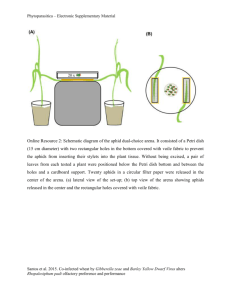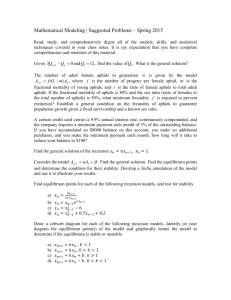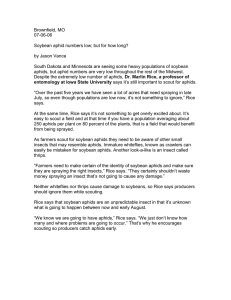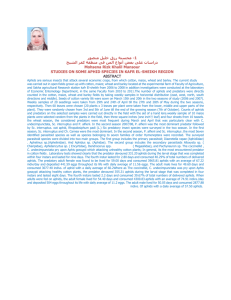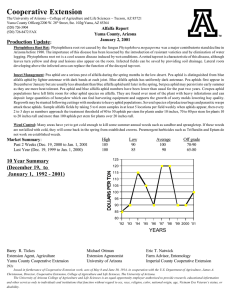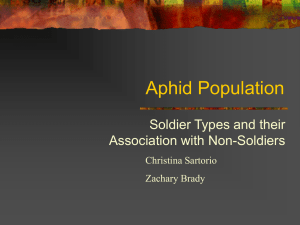Aphids on Ornamental Plants
advertisement
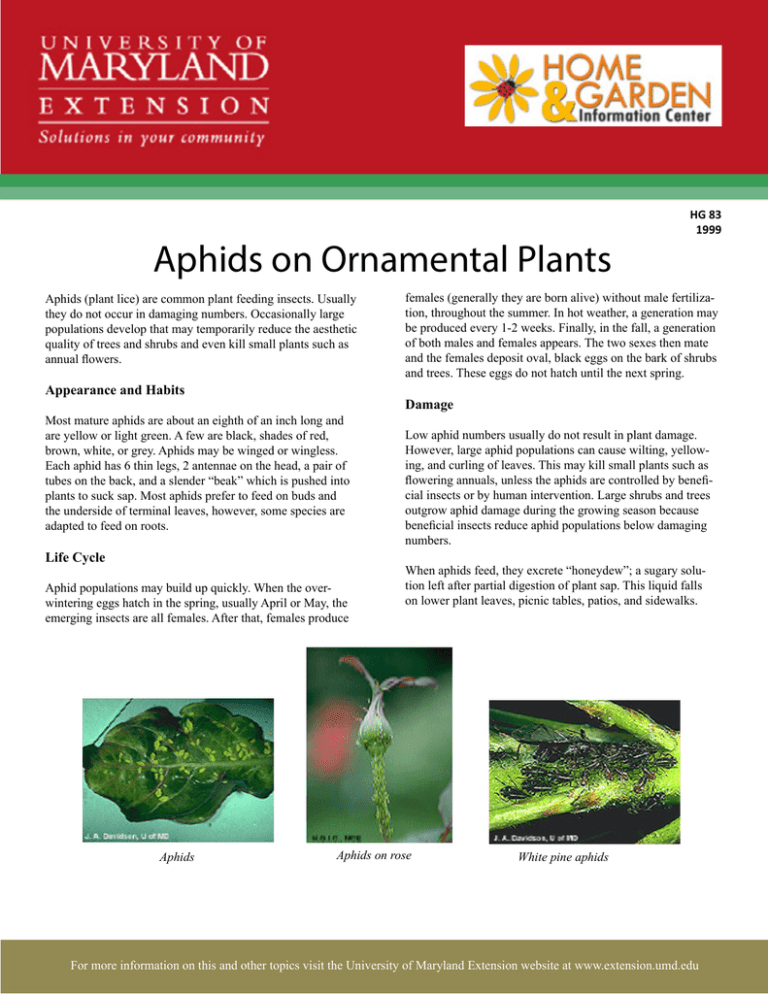
Aphids on Ornamental Plants Aphids (plant lice) are common plant feeding insects. Usually they do not occur in damaging numbers. Occasionally large populations develop that may temporarily reduce the aesthetic quality of trees and shrubs and even kill small plants such as annual flowers. Appearance and Habits Most mature aphids are about an eighth of an inch long and are yellow or light green. A few are black, shades of red, brown, white, or grey. Aphids may be winged or wingless. Each aphid has 6 thin legs, 2 antennae on the head, a pair of tubes on the back, and a slender “beak” which is pushed into plants to suck sap. Most aphids prefer to feed on buds and the underside of terminal leaves, however, some species are adapted to feed on roots. Life Cycle Aphid populations may build up quickly. When the overwintering eggs hatch in the spring, usually April or May, the emerging insects are all females. After that, females produce Aphids HG 83 1999 females (generally they are born alive) without male fertilization, throughout the summer. In hot weather, a generation may be produced every 1-2 weeks. Finally, in the fall, a generation of both males and females appears. The two sexes then mate and the females deposit oval, black eggs on the bark of shrubs and trees. These eggs do not hatch until the next spring. Damage Low aphid numbers usually do not result in plant damage. However, large aphid populations can cause wilting, yellowing, and curling of leaves. This may kill small plants such as flowering annuals, unless the aphids are controlled by beneficial insects or by human intervention. Large shrubs and trees outgrow aphid damage during the growing season because beneficial insects reduce aphid populations below damaging numbers. When aphids feed, they excrete “honeydew”; a sugary solution left after partial digestion of plant sap. This liquid falls on lower plant leaves, picnic tables, patios, and sidewalks. Aphids on rose White pine aphids 1 of Maryland Extension website at www.extension.umd.edu For more information on this and other topics visit the University The honeydew dries into a clear, shiny spot. These spots often turn black because a black fungus called sooty mold grows on them. A dense sooty mold growth shades out sunlight and affected leaves may be weakened. Honeydew also has a useful purpose; it attracts predators and parasites of aphids. Aphids also transmit many virus diseases between ornamentals. Viruses are spread from plant to plant when aphids feed on diseased plants and then move to feed on healthy plants. The viruses are carried from plant to plant inside the aphid in the insect infected plant sap. Control Biological Control Before considering sprays for aphids on shrubs and trees, carefully examine some infested leaves for the presence of natural enemy life stages. These include the eggs, larvae, pupae and adults of predators such as lady beetles (ladybugs), lacewings, and flower flies. Also, look closely for the presence of aphids containing wasp parasites. Parasitized aphids, called “mummies” are round and tan colored. When the minute wasp emerges from the aphid mummy, a small hole is left in the aphid’s back. it only takes a few predators and parasites on a small plant or branch terminal to reduce aphid populations. Physical (Mechanical) Control Ladybird beetle adult, larva and eggs Lacewing larva and adult Aphid populations can be reduced by washing the terminals of sturdy plants, such as shrubs and trees, with strong water sprays from a garden hose. Chemical Control (Outdoors) If no aphid predator or parasite life stages are present, and the level of plant damage is objectionable, control may be necessary. A commercial brand of Insecticidal soap is the safest insecticide to use. Soap kills by contact, so coverage must be thorough. Repeat applications may be necessary. Chemical Control (Indoors) Indoor sprays labeled for aphid infested house plants are usually pump sprays containing Insecticidal Soap or Pyrethrum. Be sure the chemical is labeled for indoor use and the pest and plant you want to spray is on the label. Flower fly adult and larva Author: Davidson, J. A. and M. J. Raupp, 1988. Aphids on Ornamental Plants, UM Dept. of Entomology; Revised by Mary Kay Malinoski, University of Maryland Extension Specialist, Home and Garden Information Center This publication, HG 83, Aphids on Ornamental Plants, is a series of publications of the University of Maryland Extension and The Home and Garden Information Center. For more information on related publications and programs, http://extension.umd.edu/hgic. Please visit http://extension.umd.edu/ to find out more about Extension programs in Maryland. The University of Maryland, College of Agriculture and Natural Resources programs are open to all and will not discriminate against anyone because of race, age, sex, color, sexual orientation, physical or mental disability, religion, ancestry, or national origin, marital status, genetic information, or political affiliation, or gender identity and expression. 2 For more information on this and other topics visit the University of Maryland Extension website at www.extension.umd.edu


